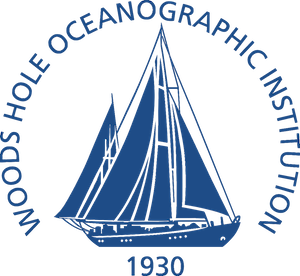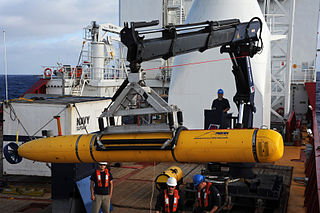Related Research Articles

The Woods Hole Oceanographic Institution is a private, nonprofit research and higher education facility dedicated to the study of marine science and engineering. WHOI is dedicated to advancing knowledge of the ocean and its connection with the Earth system through a sustained commitment to excellence in science, engineering, and education, and to the application of this knowledge to problems facing society.

A remotely operated underwater vehicle is a tethered underwater mobile device.

An autonomous underwater vehicle (AUV) is a robot that travels underwater without requiring input from an operator. AUVs constitute part of a larger group of undersea systems known as unmanned underwater vehicles, a classification that includes non-autonomous remotely operated underwater vehicles (ROVs) – controlled and powered from the surface by an operator/pilot via an umbilical or using remote control. In military applications an AUV is more often referred to as an unmanned undersea vehicle (UUV). Underwater gliders are a subclass of AUVs.

Boeing Phantom Works is the advanced prototyping arm of the defense and security side of Boeing. Its primary focus is developing advanced military products and technologies, many of them highly classified.

An underwater glider is a type of autonomous underwater vehicle (AUV) that employs variable-buoyancy propulsion instead of traditional propellers or thrusters. It employs variable buoyancy in a similar way to a profiling float, but unlike a float, which can move only up and down, an underwater glider is fitted with hydrofoils that allow it to glide forward while descending through the water. At a certain depth, the glider switches to positive buoyancy to climb back up and forward, and the cycle is then repeated.

The Monterey Bay Aquarium Research Institute (MBARI) is a private, non-profit oceanographic research center in Moss Landing, California. MBARI was founded in 1987 by David Packard, and is primarily funded by the David and Lucile Packard Foundation. Christopher Scholin serves as the institute's president and chief executive officer, managing a work force of approximately 220 scientists, engineers, and operations and administrative staff.
Unmanned underwater vehicles (UUV), sometimes known as underwater drones, are any vehicles that are able to operate underwater without a human occupant. These vehicles may be divided into the two categories of remotely operated underwater vehicles (ROUVs), which are controlled by a remote human operator, and autonomous underwater vehicles (AUVs), which operate independently of direct human input. Sometimes only vehicles in the second category are considered a kind of robot, but those in the first category are also robots similar to surgical robots, which also mostly require an operator.
Subsea is fully submerged ocean equipment, operations or applications, especially when some distance offshore, in deep ocean waters, or on the seabed. The term is frequently used in connection with oceanography, marine or ocean engineering, ocean exploration, remotely operated vehicle (ROVs) autonomous underwater vehicles (AUVs), submarine communications or power cables, seafloor mineral mining, oil and gas, and offshore wind power.

The Type 925 Dajiang (大江) is a type of naval auxiliary ship belonging to the People's Republic of China. Each ship is usually equipped with up to two Type 7103 DSRV class Deep Submergence Rescue Vehicles (DSRVs). The lead ship of the Dajiang class is the Changxingdao. The Type 925 is a submarine tender that can also be used as a submarine rescue ship, and hence, it is designated as a submarine support ship by Chinese.
Explorer autonomous underwater vehicle (AUV) is a Chinese AUV developed in the People's Republic of China (PRC), first entering service in November 1994. It should not be confused with another two Anglo-American AUVs that share the same name: the American Autonomous Benthic Explorer AUV (ABE) built by Woods Hole Oceanographic Institution, and the British Columbia-based International Submarine Engineering built Canadian Explorer AUV, which is based on its earlier ARCS AUV. Explore AUV is the first member of a series of Chinese AUVs later developed, all of which are based on Explorer AUV.
AUV - 150 is an unmanned underwater vehicle (UUV) being developed by Central Mechanical Engineering Research Institute (CMERI) scientists in Durgapur in the Indian state of West Bengal. The project is sponsored by the Ministry of Earth Sciences and has technical assistance from IIT-Kharagpur.
The Sentry is an autonomous underwater vehicle (AUV) made by the Woods Hole Oceanographic Institution. Sentry is designed to descend to depths of 4,500 metres (14,800 ft) and to carry a range of devices for taking samples, pictures and readings from the deep sea.
Stone Aerospace is an aerospace engineering firm founded by engineer and explorer Bill Stone, located in Del Valle, a suburb of Austin, Texas.
Liquid Robotics is an American marine robotics corporation that designs, manufactures and sells the Wave Glider, a wave and solar powered unmanned surface vehicle (USV). The Wave Glider harvests energy from ocean waves for propulsion. With this energy source, Wave Gliders can spend many months at a time at sea, collecting and transmitting ocean data.
Echo Ranger is a marine autonomous underwater vehicle (AUV) built by Boeing.
Autonomous Robotics Ltd, previously GO Science Ltd, is a British company founded in 2002 to develop an autonomous underwater vehicle (AUV) with ocean-bottom seismometer (OBS) sensors. Since 2014 the company has been a subsidiary of Thalassa Holdings Ltd.

The Bluefin-21 is an autonomous underwater vehicle (AUV) developed by Bluefin Robotics for defence, commercial or scientific use. It found its most famous use in April 2014 in the search for the wreckage of the missing Malaysia Airlines Flight 370.

Maya AUV is an autonomous underwater vehicle (AUV), developed by the Marine Instrumentation Division at the National Insititute of Oceanography (NIO), India.
Echo Seeker is an autonomous underwater vehicle (AUV) built by Boeing.
The Orca is an autonomous underwater vehicle (AUV) that is under development by Boeing and Huntington Ingalls Industries (HII) for the United States Navy.
References
- 1 2 3 "Boeing's Monstrous Underwater Robot Can Wander the Ocean for 6 Months". Wired Magazine. 21 March 2016. Retrieved 17 October 2020.
- 1 2 3 "Echo Voyager: New Frontiers in Unmanned Technology". Marine Technology Reporter. May 2016. Retrieved 17 October 2020.
- 1 2 "Boeing's robot submarine is back roaming off the California coast". Los Angeles Times. 23 June 2018. Retrieved 17 October 2020.
- 1 2 "Boeing's 'game-changing' robot submarine ready for testing in ocean off Catalina Island". The Orange County Register. 1 July 2017. Retrieved 17 October 2020.
- ↑ "Boeing wins $43 million contract for autonomous submarines". Workboat. 21 February 2019. Retrieved 17 October 2020.